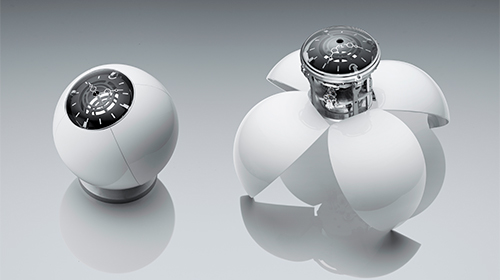MB&F & L’Epée | Orb

At first glance, the Orb looks like a futuristic model of an eye with its perfectly formed shiny sphere, and its dial taking the place of the iris and the pupil. But nothing is ever quite what it seems with the collaborative clocks of MB&F x L’Epée 1839.
The minimalistic structure of this table clock is composed of four elytra – that’s the technical word for a beetle’s protective wing covers, in case you were wondering – that not only open up, but can also swivel like a transformer to display the Orb in a variety of different positions. The shiny-white version is reminiscent of the first iPods with their lustrous curved cases, a surface that is particularly pleasing to the eye and the touch.
The possibilities of displaying the Orb are multiple. Placed on its saucer so it doesn’t roll away, it can be displayed completely closed or with one, two or three opened elytra. Alternatively, opening all four elytra makes it possible to display the clock without the saucer.
Orb starts life as a solid block of aluminium that is hollowed to create the perfect sphere. Once cut, the elytra are then coated with several layers of lacquer that are hardened in a kiln to create the brilliant finish. The four elytra are soldered to the structure with torque hinges so they can retain their angle however little or wide they are opened. When closed, the elytra are held in place with four tiny magnets on the interior of each tip to keep the shape of a perfect sphere.
Powering this state-of-the-art clock is a beautiful L’Epée 1839 hour-striking movement with an eight-day power reserve. In contrast to many of the other MB&F and L’Epée clocks, the movement is not perceptible from the outside. But the perfectly formed sphere invites the viewer into the mechanical heart of the timepiece and a discovery of the movement.
The eight-day calibre can be seen just slightly through the curved aluminium dial covered by a domed mineral glass, which has a hole in the centre to allow time-setting with a special key.
There are two separately wound barrels: one driving the time display and the other the hour-strike. The hour mechanism doesn’t just chime the passage of the hour, but indicates the actual hour, like a church clock. This function can also be repeated on demand via a button on the side of the clock, or turned on and off if required.
This new hour-striking development is based on a similar mechanism used in L’Epée 1839’s historic carriage clocks. In France, these are known as “Officer’s clocks”, as legend has it that when Napoleon almost lost a battle because one of his officers was late, he ordered all of his military chiefs to carry a carriage clock with them at all times.
Available in white or black, the Orb won’t be able to accompany its owners out into the field, but with its hourly striking mechanism, it is a beautiful reminder of the time as it passes for all desk warriors!
Inspiration
The idea behind the Orb is the brainchild of German designer Maximilian Maertens, who started his artistic career at MB&F as an intern before setting up his own design studio in Berlin. Maertens worked with MB&F and L’Epée on the T-Rex clock, before being given free rein to create the TriPod and now the Orb.
Realisation
While Maximilian Maertens and MB&F came up with the concept and design of the Orb, it was L’Epée 1839 that developed the movement as well as the lacquered transformable sphere. The Jura-based house produces all the components, except for the mineral glass and the jewels, assembles them and adjusts the high-precision eight-day movement.
While nothing about this atypical project was easy, L’Epée faced two major challenges. The first was making the sphere in four pieces so that they could be totally transformable, durable, and also form a perfect sphere when closed.
The second significant challenge was developing the striking system. Usually, with a bell-chiming mechanism, gravity is needed to strike the bell. As the Orb’s brass bell can find itself in an infinite number of different positions, L’Epée 1839’s clockmakers incorporated several springs to strike the bell so it can chime even when it is flat. The system is a hybrid between a clock and a watch striking mechanism.
Orb
The word orb comes from the Latin orbis, meaning “circle” or “disc”. The word is also the basis of the word “orbit”, a word that has stayed in the modern-day vernacular even if orbits are now known to be elliptical and not at all round.
Orbs are also used today in fanfiction to mean eyes, as in “cerulean orbs” that designate blue eyes or “chocolate orbs” for brown eyes – a nod to perhaps the first thing that comes to mind when we first lay eyes on the Orb.